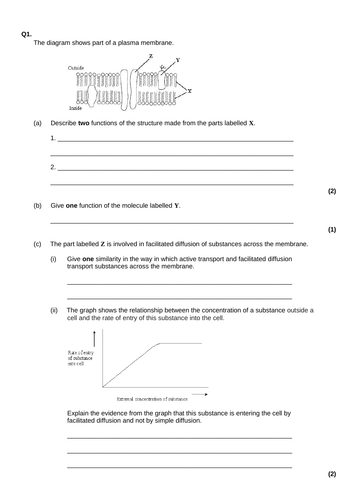


This lesson is designed for the NEW AQA AS-level Biology course, particularly the ‘Cells’ module.
For more lessons designed to meet specification points for the NEW AQA A-level Biology course please visit my shop: https://www.tes.com/teaching-resources/shop/SWiftScience
A-Level lesson format: I teach in more of a lecture style compared to GCSE. In the majority of my A-level lessons the beginning portion of the lesson is mainly teacher-led, where students are expected to take notes onto a handout/in their books. This is then mixed in with student-led activities, as well as questions and exam prep.
You will find some of my slides have blank spaces for you to add more detail/descriptions/explanations. If you look at the ‘Notes’ section underneath each of these slides, you will find additional content which you can add in as you teach!
This lesson on diffusion begins with a starter discussion to remind students of the functions of the proteins in the cell membrane and the ‘fluid-mosaic’ model.
Students will then ‘think > pair > share’ to discuss what sorts of substances cells import/export across the cell membrane. They should also examine why the cells import/export these substances. Answers are on the slide for self-assessment.
Diffusion is then laid out in two diagrams to explain the passive nature of diffusion. Students should use these diagrams to inform the next ‘think>pair>share’ and discuss with a partner what factors might affect the rate of diffusion.
Students are then introduced to facilitated diffusion, and the proteins required. They should take detailed notes on the features and functions of channel proteins and carrier proteins.
Another form of facilitated diffusion is then introduced, in which the carrier protein picks up molecules of a matching shape, rather than changing its own shape.
To quick check student understanding, they are asked three questions to answer in their books regarding the two forms of facilitated diffusion in comparison to simple diffusion, answers are provided on the next slide for self-assessment.
Students will then complete an exam-style question, as always, a marking scheme is available for self-assessment.
The plenary is a WhatsApp message task for students to draft a message to a friend, telling them what they’ve learned this lesson.
All resources are included. Thanks for looking, if you have any questions please let me know in the comments section and any feedback would be appreciated :)
Something went wrong, please try again later.
This resource hasn't been reviewed yet
To ensure quality for our reviews, only customers who have purchased this resource can review it
Report this resourceto let us know if it violates our terms and conditions.
Our customer service team will review your report and will be in touch.